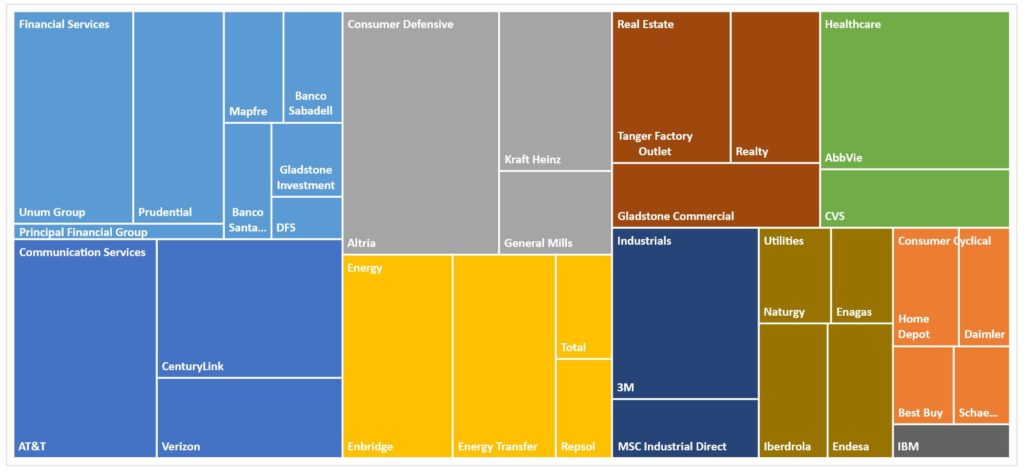Another month has gone by and the monthly review of my Dividend Growth portfolio helps me to keep track of my journey to financial independence. Yet another month with the markets going up, up, and further up. Nevertheless, there are always oportunities to find quality stocks that are undervalued. As a dividend growth investor the dividend income generation is the key driver, but it makes me happy to have invested in stocks that demonstrate growth, too. Buying undervalued stocks reduces the downside risk of the investment.
At the end of November, my investment fund has moved to $75,405, up from $73,282 in the previous month. An increase of $2,124 or 2.9% that is. The current dividend Yield on Cost (YoC) of my purchases is 5.79%, up from 5.70% last month. The increase is mostly related to my purchase of the month with an astonishing dividend yield – more about this later. Additionally I try boost my returns by selling stock options and I reinvest this money directly into more shares. For this reason, the overall Yield on Cost of my money injected is 6.72%. This month, however, my positions have not gone well and I will draw up a set of rules to avoid me taking on too much risk. This is one of the big goals I have for 2020 and forward.

My PADI (Predicted Annual Dividend Income) has further increased to $4,063. This is a plus of $51 from the $4,012 last month (+1.3%). Until now, I was having quite strong ups and downs of the monthly income but with the latest setup this is starting to take a positive trend to have more stability at least on a quarterly basis. I started just about a year ago to really focus on dividend growth investing and I am really happy with the progress during 2019. Well, the year is not over yet but with the holidays approaching I plan to review my portfolio in depth and I am already working on how I want to do this. This will be for another post in January. Check out my current state on the PORTFOLIO page.
Stock Purchases
During the month of November we have seen a lot of stock price increases and finding a suitable investment opportunity was not easy. However, I there was one opportunity that I could not let go by without pulling the trigger. One more time, I invested my hard earned capital only into a company I already own.
There are two reasons I add to current positions. On the one hand, I believe that once I decided to invest into a company and the fundamentals have not changed, I will pick up more shares as long as the company remains at or below fair value. On the other hand, I do not want to inflate the number of compnaies I hold to a number that becomes difficult to track and manage. Diversification is important but at the same time the benefit for a hihgly diversified portfolio is only marginal.
Purchase #1: Energy Transfer LP (ticker: ET)
Number of shares: 100
Average cost: $11.10
Annual dividend: $1.22
Dividend yield: 10.99%
5-year growth rate: 13.35%
EPS Forward: $1.41
P/E: 9.3
Payout Ratio: 89%
Current porfolio value: $3.555 (4.7%)
Current porfolio PADI: $366 (9.0%)
That’s it. Only one purchase in November. I had increased my position in ET just last month but a drop to almost $11 per share seemed to punish the stock oo much and I considered it significantly undervalued. A massive yield of almost 11% that adds $122 to my PADI but it comes at a price of a very high payout ratio of 89%. I prefer companies with a low or reasonable dividend payout ratio. I consider anything below 50% as low and below 70% as reasonable. ET for its nature of business tends to have a higher payout ratio but figures over the last 2 years have improved and I feel more comfortable with it.
Stock Sales
As a dividend growth investor I tend to stick to a buy-and-hold strategy. The target is to aquire companies that raise their dividends over time that are fairly or even undervalued. In the long run this will increase the total return and reduce the downside risk. At the same time, when the outlook and prospects of a company change that it may be time to consider selling, I re-evaluate and may end up selling the stock.
Sale#1: Bolsas y Mercados Españoles (MAD:BME)
This month this was the case with Bolsas y Mercados Españoles (MAD:BME). I purchased the stock back in August 2018 as one of my first stock in my dividend growth portfolio. Unfortunately, the share price dropped to as low as 20 euros during 2019, then recovered a bit about rumors about the potential takeover. And on 19th of November the takeover bid came in from SIX Group at an offer price of 34 euros per share. Obviously, the market immediately reacted and the share price skyrocketed. There were comments on a potential bidding war between other interested parties but I felt it was a stock I wanted to reduce / sell anyway. The dividend alos stagnated. So a nice little present which I accepted gratefully.

As a result, I brought in a return of 31.6% over a period of 15 month. A position I had planned to use to optimize the tax impact in 2019 turned into a profitable position. I take it any day.
The sale reduced my PADI by $62.74 (depending on exchange rate), but I used the cash to proceed with the purchase of ET mentioned above and came out winning.
Conclusion
These 100 shares purchased of ET during November have added $122.00 and the 36 shares sold have reduced $62.74 so that I gained $59.26 to my proyected annual dividend income (PADI) which now stands at $4,063. There is a small gap of $10 dolar to previous month’ data due to exchange rate fluctuations.
Disclosure: At time of writing long ET and I sold all shares of BME
Disclaimer: I am not a professional investment or financial advisor. The information presented on this site represents my personal dividend growth journey and it is for informational purposes only. Opinions expressed are my own and should NOT be relied on or taken as investing advice. I have no knowledge about your personal situation and before you make any investment decision you should exercise due diligence and must do your own research. Always consider seeking advice from a professional financial and tax advisor.

